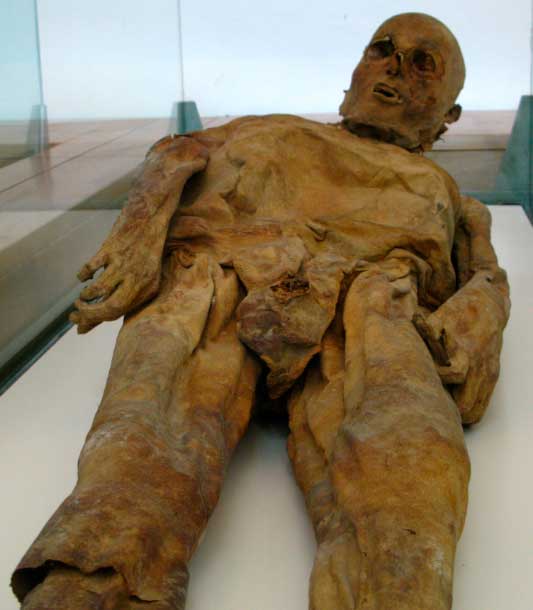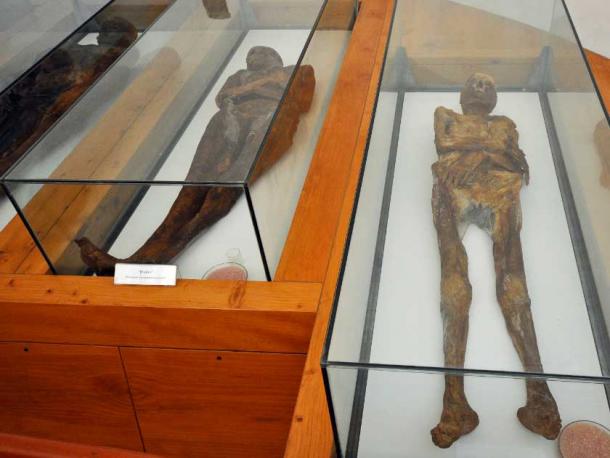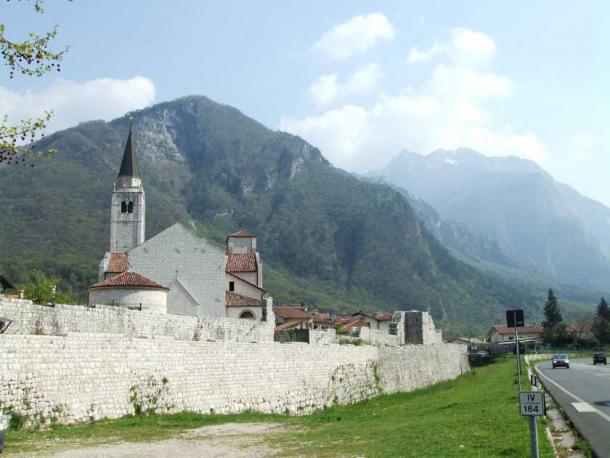
What Caused the Natural Mummification of the Mummies of Venzone?
Italy is famous for many things, but did you know it’s also famous for mummies? The Venzone mummies are a collection of over forty mummies found in Venzone, Italy in the 17th century. Although these naturally-preserved mummies are similar to others found throughout the world, archaeologists were baffled at the discovery of so many in one place. How were so many of these bodies naturally preserved, and why did the number of preserved mummies dwindle over time? Experts studying this discovery have some fascinating insights.
- New Greco-Roman Tomb with 20 Mummies Found in Aswan
- Mummies Scanned to Unravel the Beautiful Mysteries Bound Inside

One of the Venzone mummies, exhumed in 1811 (Joadl / CC BY SA 3.0)
A Chilling Construction Discovery
Workers discovered the first mummy of Venzone in 1647, in a 14th-century tomb located below the town’s cathedral. They were renovating the cathedral to increase its size, when they discovered the preserved remains of a man in an underground crypt. Archaeologists estimate that this first mummy dated back to the 1300s, when the tomb was first built. His body was completely dried, leaving his total body weight at approximately 33 pounds (14.9 kilograms). He also had a curved back, giving him the nickname “ Gobbo” or ‘hunchback.’ Workers at the cathedral left the mummy there at the time, as they had no way to formally extract or analyze it.
Additional mummies were discovered in the decades following this renovation, all weighing between 22 and 44 pounds (9.9 to 19.9 kilograms). The mummies were not extracted until the 19th century, when trained archaeologists relocated them from the crypt to the upper chapel. From there, many were transported to the University Cabinet of Padua, the Museum of Vienna, and the Church of the Invalids in Paris for further analysis. The results of the research done on these bodies is unclear and not currently publicized.
During this time, approximately twenty one mummies were left behind at the site of the cathedral. During an earthquake in 1976, six of those mummies were destroyed. The remaining fifteen were extracted from the church ruins and had little damage. They still remain in Venzone to this day. While some are available for analysis, others are either buried or on display for locals to observe. This has left few samples available for researchers to experiment with, although they do already have some thoughts about the preservation of these bodies.
- Desecration and Romanticization – The Real Curse of Mummies
- Why Did Ancient Scots Prepare ‘Frankenstein’ Mummies?

The Venzone mummies remain on display in the Cemetery Chapel of Saint Michael (Jean-Marc Pascolo / CC BY SA 3.0)
How were the Venzone Mummies created?
Analysis of the mummies determined that mummification must have taken place during the first year after burial. The mummies had little decay, but were completely devoid of fluids and had dry, papery skin. Experts analyzing the mummies began to formulate causes of the mummification, as the bodies had little to no decay beyond dehydration. Because of the limited information available, they came to a few different conclusions.
Some researchers in the 19th and 20th centuries believed that the mummies were preserved due to the presence of a unique species of fungus. Hypha tombicina, named after the tomb the mummies were found in, was a fungus found throughout the mummies’ tomb. The fungus was found on the tomb walls and the wooden coffins the bodies were found in, which led to this hypothesis. Researchers noted that the fungus is capable of absorbing significant amounts of liquid, which could have dried and preserved the bodies in their intact state.
Others had doubts about this conclusion. Some speculated that there wasn’t enough of the fungus found inside the coffins or on the bodies to have fully preserved them. These individuals state that the mummies were buried in a tomb with limestone floors, and claim this could have caused the mummification seen in these bodies. Some recent studies even claim that there was no Hypha tombicina, and that the existence of this fungus was fabricated to provide a quick answer to this mysterious phenomenon.
To this day, the exact cause of the mummification of these bodies is largely unknown. Although fungus and limestone have been hypothesized as causes, researchers have not yet come to a definitive conclusion. It is possible that these two factors may have even worked together to produce the dried yet perfectly preserved bodies discovered in the tomb so many years ago. Only with further research can experts potentially determine the truth.

Venzone, Italy is a picturesque village, with bonus mummies! (Sebi1 / Public Domain)
Forever a Mystery? Visit and Find Out
Experts have analyzed samples from the mummies for several decades to determine the cause behind the mummification. Unfortunately, archaeologists have little to work with, as those with jurisdiction over the bodies have long refused to allow further sample collection. The authorities say religious and personal reasons have prevented them from allowing further analysis of the bodies by experts in the field. Because of this, only samples taken during the initial extraction and transport of these bodies are available for study. This has likely contributed to the unknown cause of the mummification, as testing done on original samples has been inconclusive.
Another issue is that researchers cannot replicate these conditions. While they could attempt similar mummification using limestone or fungus, they cannot fully replicate the exact conditions within the tomb itself. Plus, because burying the dead in churches was banned before the full extraction of the mummies, there is no abundance of additional samples to analyze. Regardless, researchers involved in this discovery have proposed some fascinating hypotheses about the mummies, which could be tested in later studies.
Today, five of the mummies are on display in the Cemetery Chapel of Saint Michael in Venzone. Curious visitors willing to travel to Italy can observe them year-round, as it is currently a permanent exhibit. If you ever find yourself in Venzone, check out these mysterious mummies for yourself.
Top image: Two of the creepily preserved Venzone mummies. With normal decomposition, teeth tend to fall out several weeks after death. Source: Left; Joadl / CC BY SA 3.0 Right; Joadl / CC BY SA 3.0
By Lex Leigh
References
effeemme. January 22, 2019. The Mummies of Venzone. Atlas Obscura. Available at: https://www.atlasobscura.com/places/mummie-di-venzone
Margaritoff, M. December 1, 2020. 55 of History's Creepiest Pictures - and their equally disturbing backstories. All That's Interesting. Available at: https://allthatsinteresting.com/creepy-pictures#40
Strange Mummies of Venzone: Ancient Bodies that Never Decompose Remain an Unsolved Mystery. July 9, 2016. MessageToEagle.com. Available at: https://www.messagetoeagle.com/strange-mummies-venzone-ancient-bodies-never-decompose-remain-unsolved-mystery/
Visit the Permanent Museum Dedicated to the Mummies of Venzone. Venzone, a salon within the walls. April 21, 2022. Available at: http://www.venzoneturismo.it/en/visit-venzone/permanent-museums/#:~:text=THE%20MUMMIES%20OF%20VENZONE,-The%20natural%20mummification&text=The%20oldest%20mummy%2C%20the%20Hunchback,the%2018th%20and%2019th%20centuries
















Comments
If Plato’s account of the destruction of Atlantis is true, then it’s annihilation may have been via nuclear bombing, which if massive, could generate regional radiation fallout, essentially creating sterile zones, where no form of life can survive. The fallout, being heavier than air, would settle in the caverns and catacombs. Add the zero back to Plato’s timeline, and it would have happened around 115k BC, at the rapid onset of the Ice Age.
Nobody gets paid to tell the truth.